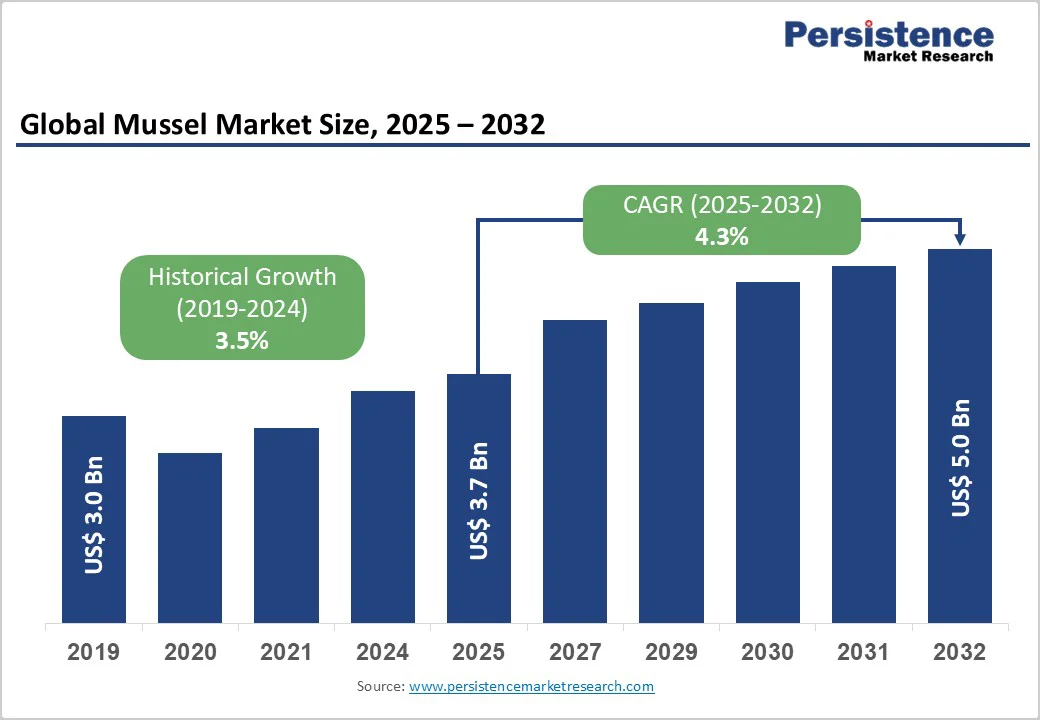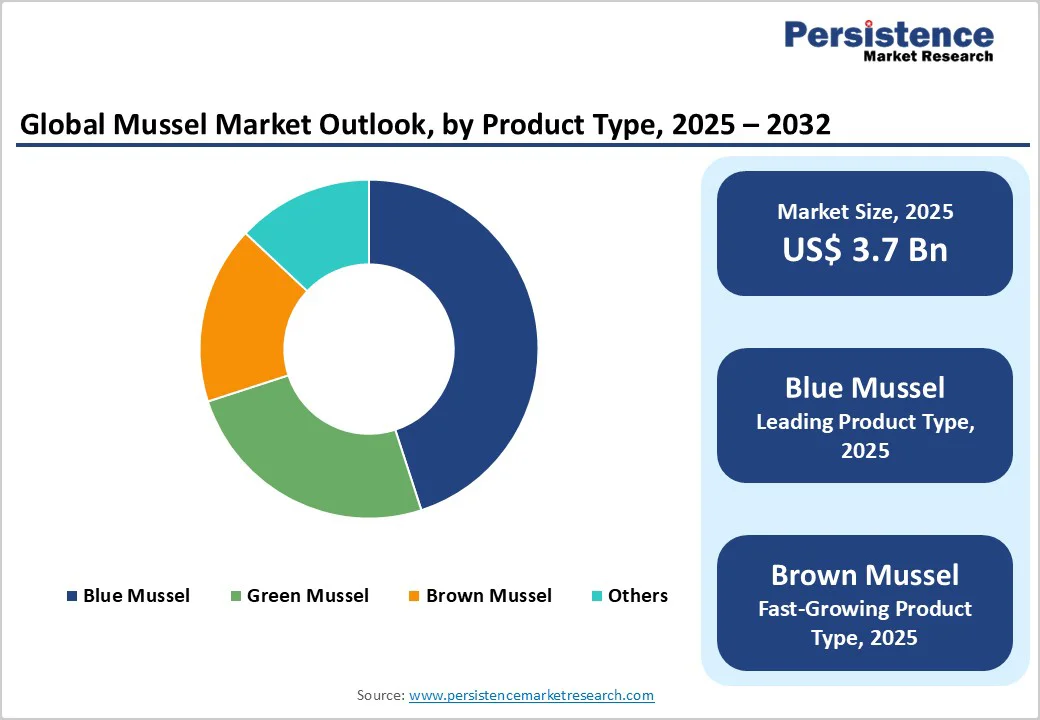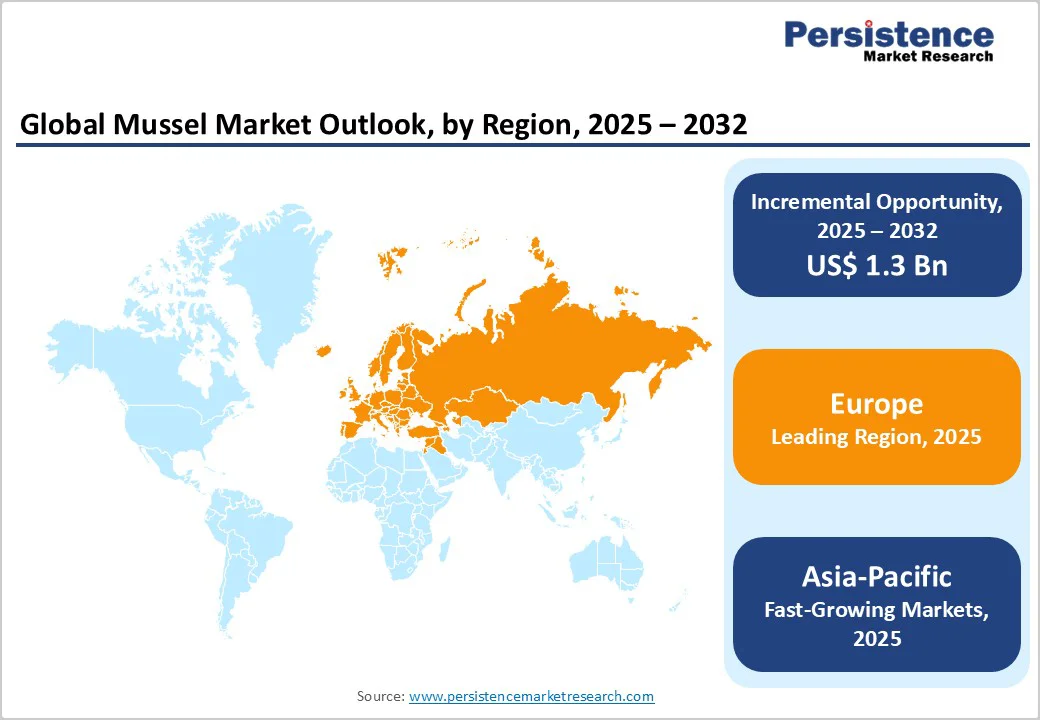ID: PMRREP33184| 199 Pages | 17 Nov 2025 | Format: PDF, Excel, PPT* | Food and Beverages

The global mussel market is estimated to grow from US$ 3.7 Bn in 2025 to US$ 5.0 Bn by 2032. The market is projected to record a CAGR of 4.3% during the forecast period from 2025 to 2032.
The global mussel market is growing steadily, driven by rising seafood consumption, health awareness, and sustainable aquaculture practices. Asia-Pacific leads due to abundant coastal resources and expanding aquaculture, while Europe and North America emphasize premium, organic, and eco-certified mussel products, supported by growing consumer preference for protein-rich and environmentally responsible seafood options.
| Key Insights | Details |
|---|---|
|
Global Mussel Market Size (2025E) |
US$ 3.7 Bn |
|
Market Value Forecast (2032F) |
US$ 5.0 Bn |
|
Projected Growth (CAGR 2025 to 2032) |
4.3% |
|
Historical Market Growth (CAGR 2019 to 2024) |
3.5% |

One major driver of the global mussel market is the rising demand for sustainable protein sources, particularly amidst concerns over land-based agriculture’s environmental impact. Farmed mussels are highly efficient: for example, the production of 1 kg of edible mussel meat emits only about 0.6 kg CO?e, compared to ~19–36 kg CO?e for beef. According to the National Oceanic and Atmospheric Administration (NOAA), mussels require no feed inputs and naturally improve water quality by filter-feeding. In addition, mussels provide high-quality protein (e.g., ~16 g per 100 g cooked), along with B12, iron and omega-3s making them nutritionally comparable to conventional animal proteins yet far gentler on the environment. Together, these factors strengthen the position of mussels as a viable sustainable protein alternative and are fuelling market growth.
Filter-feeding mussels accumulate toxins, bacteria and pollutants from their environment, posing risks to human health when consumed. For instance, marine biotoxins such as those causing diarrhetic shellfish poisoning (DSP) have been linked to mussel consumption in China, where an outbreak was confirmed after detection of okadaic acid and dinophysistoxin-1 in mussels from markets. In Europe, the European Environment Agency found that hazardous substances (e.g., benzo[a]pyrene, PCB, lindane) exceeded safe limits in mussel tissue at various locations. Additionally, the U.S. Food and Drug Administration reports shellfish, including mussels, are associated with more than 100,000 illnesses annually in the U.S. due to pathogens, toxins or other hazards. These issues increase regulatory burdens, drive product recalls, require rigorous testing and thus limit market growth and consumer confidence.
One promising opportunity for the Mussel market lies in its application in functional and nutraceutical products, based on solid nutritional evidence. Mussels provide approximately 440–780 mg of long-chain omega-3 fatty acids (EPA + DHA) per 100 g, with one study reporting a mean of 518.9 mg/100 g cooked mussel. When consumed three times weekly over two weeks, participants showed a significant increase in omega-3 blood status (omega-3 index rising from ~4.27 to ~5.07). In addition, mussel extracts (e.g., from Green?Lipped Mussel) show anti-inflammatory properties in vitro, suggesting potential joint-health benefits. Together these data support growth in mussel-based nutraceuticals and functional foods, creating a clear growth opportunity for the market.
Blue Mussel dominates the market with 45.0% share in 2025 due to its wide availability, adaptability to cold-water aquaculture, and strong consumer demand across Europe and North America. According to the European Commission, France, the Netherlands, and Ireland collectively account for nearly 90% of Blue Mussel production in the Atlantic-Northeast region. France alone reported an average farm-gate price of €2.26 per kg in 2021, reflecting strong market value and consumer preference. Blue Mussels thrive in sustainable long-line and “bouchot” farming systems, offering consistent yields with minimal environmental impact. Their mild flavor, rich protein and omega-3 content, and suitability for fresh, frozen, and processed seafood products make them the preferred species in both domestic consumption and export markets.
The Whole/Intact form dominates the global mussel market primarily because it preserves freshness, enhances visual appeal, and aligns with consumer preference for naturally presented seafood. According to the European Market Observatory for Fisheries and Aquaculture Products (EUMOFA), fresh whole mussels had a household penetration rate of 15.3% in 2020, compared to only 1.6% for frozen products. This reflects strong demand for live and freshly cooked mussels in Europe’s retail and foodservice sectors. Whole mussels also reduce processing costs, simplify cold-chain logistics, and are favored in premium restaurant menus for their authenticity and presentation. Their intact shells help retain flavor and nutrients during cooking, making them the preferred form for both domestic consumption and international trade.

Europe region dominates the global market with 44.5% share in 2025, due to high seafood consumption, and advanced sustainability practices. According to Eurostat (2023), mussels represent about 34.5% of the EU’s total aquaculture output by live weight, making them one of Europe’s most farmed shellfish species. The European Market Observatory for Fisheries and Aquaculture Products (EUMOFA) reported that the EU produced approximately 396,390 tonnes of mussels in 2022, worth around €455 million. Major producers include Spain, France, the Netherlands, and Ireland. Spain remains the largest consumer, with 3.54 kg per capita annual consumption, far above the EU average of 1.2 kg. Europe’s dominance is driven by strong domestic demand, established supply chains, and innovative farming methods like “bouchot” culture in France and long-line systems in Ireland.
Asia-Pacific is the fastest-growing region in the mussel market. According to the Food and Agriculture Organization (FAO), Asia produced around 46.9 million tonnes of aquaculture output (excluding aquatic plants) in the early 2000s, representing 89% of the world’s total for aquatic animals. In bivalves (which include mussels), more than 85% of global production occurs in Asia. In countries such as China, production of farmed bivalves rose from 9.51 million tonnes in 2004 to 14.95 million tonnes in 2023, a nearly 57% increase. These large volumes, combined with rising disposable incomes, growing bakery and seafood industries, and shifting dietary preferences toward seafood in India and China, drive about Asia-Pacific’s rapid growth in the mussel market.
North America is an important region in the mussel market due to its growing focus on sustainable aquaculture and high seafood consumption. The U.S. National Oceanic and Atmospheric Administration (NOAA) highlights shellfish farming, including mussels, as one of the most environmentally efficient forms of seafood production, contributing significantly to coastal economies. In Canada, mussel farming is concentrated in Prince Edward Island, producing over 22,000 tonnes annually, which accounts for more than 80% of the nation’s blue mussel output. (fisheries.noaa.gov / dfo-mpo.gc.ca) The region’s rising demand for low-fat, protein-rich foods and government initiatives promoting sustainable seafood, such as NOAA’s Aquaculture Strategic Plan support continued industry growth. These efforts make North America a key hub for innovation, sustainable farming, and expanding domestic consumption in the global mussel market.

The global mussel market is growing steadily as producers adopt sustainable aquaculture, advanced processing, and eco-friendly packaging. Leading suppliers emphasize freshness, traceability, and certified sustainable farming, while demand rises from retail, foodservice, and export sectors. Increasing consumer preference for protein-rich, natural, and environmentally responsible seafood continues to support long-term market expansion worldwide.
The global mussel market is projected to be valued at US$ 3.7 Bn in 2025.
Rising seafood demand, sustainable aquaculture expansion, health benefits, protein-rich diets, and increasing consumption in foodservice and export markets drive growth.
The global mussel market is poised to witness a CAGR of 4.3% between 2025 and 2032.
Expanding sustainable aquaculture, value-added mussel products, nutraceutical applications, emerging Asian markets, and eco-certified seafood demand offer strong growth opportunities.
American Mussel Harvesters, Inc., Atlantic Aqua Farms, BLUE OCEAN MUSSELS, Camanchaca S.A., Kingsun Foods Co., Ltd, Kush Shellfish, and Others.
|
Report Attributes |
Details |
|
Historical Data/Actuals |
2019 - 2024 |
|
Forecast Period |
2025 - 2032 |
|
Market Analysis |
Value: US$ Bn Volume: Tons |
|
Geographical Coverage |
|
|
Segmental Coverage |
|
|
Competitive Analysis |
|
|
Report Highlights |
|
By Product Type
By Form
By Application
By Distribution Channel
By Region
Delivery Timelines
For more information on this report and its delivery timelines please get in touch with our sales team.
About Author